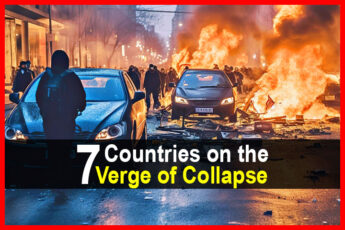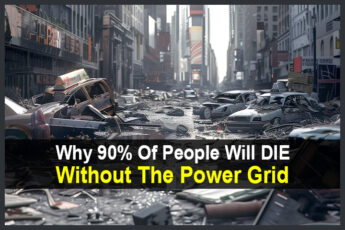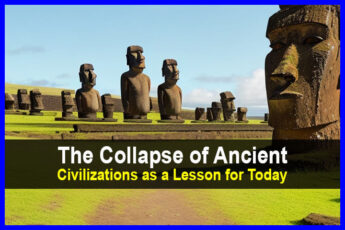Estimated reading time: 12 minutes
When we think about an event that could lead to the collapse of society our minds often drift towards the catastrophic disasters we see in the movies: Asteroids obliterating a continent, super-volcanoes plunging the Earth into decades of non-stop winter, even nuclear war or rare events like pole shifts, alien invasions or, in the minds of some people – a zombie apocalypse.
In the meantime, our greatest concerns are dominated by those events that have a statistical probability of actually happening. Things like hurricanes, wildfires, earthquakes, tornadoes, floods and even a pandemic. The effects of those disasters are significant and recovery is always a challenge, but people do recover and life and society goes on.
Regardless of the level of the event or duration, in each instance the disaster was defined by one event that often occurs quickly or, in the case of a pandemic, lingers over time. However, there have been some notable occurrences in the last decade that are starting to demonstrate a troubling pattern.
Want to save this post for later? Click Here to Pin it On Pinterest!
It’s the occurrence of complex events where more than one disaster strikes an area at the same time. Historically that’s not unusual, but it was usually defined as a once in a thousand year event, or just bad luck rather than a repeating pattern of compound disasters.
What Is a Compound Disaster?
A compound disaster is when meteorological, geological, biological or sociological disasters strike an area in rapid succession. They are not related directly to each other like the cascading disasters that we’ll cover later in this article, but seem to transcend statistical probability and the old blame game of bad luck.
The greatest challenge with a compound disaster is the inability to effectively allocate resources for rescue and recovery. In many cases those resources are already limited and oftentimes insufficient.
Here are some examples:
- The Covid pandemic highlighted the impact of a compound disaster. In 2020 a warehouse of ammonium nitrate exploded in Beirut, Lebanon. The blast was the equivalent of 500 tons of TNT. Urban search and rescue specialists were dispatched but had to follow a Covid quarantine policy that prevented them from conducting immediate search and rescue operations.
- In 2022 Pakistan witnessed melting glaciers from the record spring heat and this, combined with an unprecedented monsoon rain, resulted in historic flooding that devastated a large part of the country. It was a unique example of compounding disasters where a heat wave triggered the melting of glaciers and the event converged with a large scale monsoon resulting in drawn out flooding and attendant water-borne diseases.
- Puerto Rico has also experienced a compounded series of events without substantial respite in years, starting with an outbreak of Zika virus in 2016, Hurricane Maria in 2017, earthquakes in 2019/2020, and COVID-19 2020/2023. These events are superimposed on extreme social inequities
Why Are Compound Disasters Happening More Frequently?
5 vulnerabilities emerge as the drivers of compound disasters.
Growing vulnerability is the primary reason compound disasters are not only occurring but having such a significant impact. These vulnerabilities are defined by some things we have been talking about for far too long.
1. Population Growth
As the world’s population continues to grow exponentially, more and more people are occupying areas that have been historically at risk from natural disasters. There are numerous YouTube videos of floods and landslides wiping out neighborhoods and villages that appear to be located in precarious locations.
Those areas are not prime real-estate, but for people living in poverty, there's no choice. The unfortunate result is more and more people are in highly vulnerable locations where the worst of any natural disaster will have the greatest impact and cause the most damage.
The math is unfortunately simple. The scale of any disaster is measured by the impact it has on human life. An earthquake in Antarctica will have little impact on human life. An earthquake in Tokyo, Los Angeles, or Rome will be defined as devastating simply because of the number of people affected. As the world population grows, so does our vulnerability and the number of memorable disasters.
2. Climate Change
Disaster theorists are pointing more and more to climate change as a primary driver of compound disasters. Whether it’s drought, flooding, intense heat waves, sea-level rise, or just the chain of events that emerge from the chaos theories that drives our weather, climate change is here to stay.
The worst-case scenarios project temperatures by the 22nd century that last prevailed in the Early Eocene, reversing 50 million years of cooler climates in the space of two centuries. This is particularly alarming, as human societies are locally adapted to a specific climatic niche. The rise of large-scale, urbanized agrarian societies began with the shift to the stable climate of 12,000 years ago.
Since then, human population density peaked within a narrow climatic envelope with a mean annual average temperature of 55°F. Even today, the most economically productive centers of human activity are concentrated in those areas. The cumulative impacts of warming may overwhelm society’s adaptive capacity.
2020 was a benchmark year for climate driven disasters. They included the Southern California wildfires, Australia bushfires, record-breaking heat in Death Valley, typhoons in East Asia, tropical storms and hurricanes in the Gulf of Mexico, and historic flooding in Midland, Michigan, which led to a dam failure and extensive property damage. In the midst of these extreme events most of remember that Covid showed up in early 2020.
The tropical Pacific has been in a La Niña state throughout the year and the period from August to October 2022 marked the first “triple-dip” La Niña event of the 21st century. This, coupled with a warmer planet, created a series of extreme weather events world-wide.
The 2022 Pakistan flood which affected 33 million people and caused 1,739 deaths was a notable example. The World Weather Attribution study released on 15 September 2022 showed “fingerprints” of climate change on this extreme monsoon rainfall in Pakistan. Bangladesh and India also experienced flood last year which affected 7.2 million and 1.3 million people respectively.
The global climate is now entering an El Nino phase that climatologists are calling a “Super El Nino.” The result will be more weather extremes fueled by the continuing rise in overall world temperatures. Meteorologists haven’t missed the significance of the first occurrence of a combined triple-dip La Nina followed by a Super El Nino. Mark it up as another risk factor for compound disaster.
3. Civil Unrest
Historically, civil unrest has been driven by a general sense of injustice and unfairness in a society. New drivers of civil unrest continue driven by polarizing politics and the re-emergence of dictatorships. In case you’re taking notes, here’s a list of the countries under dictatorship in 2023:
- Afghanistan
- Algeria
- Angola
- Azerbaijan
- Bahrain
- Bangladesh
- Belarus
- Brunei
- Burundi
- Cambodia
- Cameroon
- Central African Republic
- Chad
- China
- Democratic Republic of the Congo
- Republic of the Congo (Yes, there are 2 Republics of the Congo)
- Cuba
- Djibouti
- Egypt
- Equatorial Guinea
- Eritrea
- Ethiopia
- Gabon
- Iran
- Iraq
- Kazakhstan
- Laos
- Libya
- Myanmar
- Nicaragua
- North Korea
- Oman
- Qatar
- Russia
- Rwanda
- Saudi Arabia
- Somalia
- South Sudan
- Sudan
- Eswatini/Swaziland
- Syria
- Tajikistan
- Tibet
- Turkey
- Turkmenistan
- Uganda
- United Arab Emirates
- Uzbekistan
- Venezuela
- Vietnam
- Western Sahara
- Yemen
If you’re familiar with any of those countries, you are probably aware of the general suffering and instability of many of those regimes. Many of these countries reported some of the worst outcomes as a result of the Covid pandemic, while others reported nothing or denied the facts. If more countries succumb to the ruthless indifference of dictatorships, the global economy will be at great risk.
4. Systemic Failure
Many countries around the world do not have robust or stable economies, healthcare systems, emergency management, education, or dependable infrastructure providing electricity, clean water, or food security. The weakness of those systems makes a fragile population particularly vulnerable when any disaster strikes. When one occurs immediately after another, the social order is quickly overwhelmed.
But it’s not just about impoverished nations. Most every country has a percentage of its population living in poverty, and for those without the means to enable resilience – their lives and those of their neighbors collapse.
To this day there are still neighborhoods and towns in Louisiana that have still not recovered from Hurricane Katrina. Entire villages are still in ruins in Puerto Rico from Hurricane Maria. And the list goes on….
Driven by the hazard characteristics and the underlying diverse socio-economic vulnerabilities and exposure, the major disasters in 2022 were complex with compounding impacts.
For example, the 2022 earthquakes in Afghanistan and Indonesia were mild with 5.9 and 5.6 magnitudes, but the impacts of both were relatively severe. The fundamental reason was the critical vulnerability of a community at risk and direct exposure of economic and social assets near the epicenters of the earthquakes.
In 2012 a coronal mass ejection of the magnitude of that which occurred in 1859 narrowly missed the Earth. Had it reached us, we might have endured widespread disruption of global positioning systems, satellites, telecommunications and electricity supply. A ‘Carrington event’ of this magnitude would arrive with 150 billion times the energy of the Hiroshima nuclear bomb.
Geomagnetic-induced currents and ionizing radiation would potentially wreak havoc with technology. Unfortunately, the extent of dependency on the affected technologies is still poorly mapped. Hence, there would be some unpleasant surprises.
In the case of compounding risk, simultaneous hazard events took place followed by their respective or combined impacts. As Afghanistan was already simultaneously struggling with perennial conflicts, pandemic and disasters, the June earthquake led to a number of impacts and resulted in a substantially accumulated residual impact, which then became further multiplied when unseasonal rainfall and floods arrived shortly afterward
5. The Global Marketplace (Globalization)
More and more, countries are reliant on global trade to supply a broad range of goods and services. As countries succumb to disasters, the ability of many countries to supply its population with basic goods and services will become further compromised.
And it’s not just about the global supply chain and the Covid pandemic; there are numerous examples that point to a precarious situation threatening any society regardless of the health of its economy or population. The case of the Taiwan Earthquake in 1999 is one such example.
- The earthquake occurred in central Taiwan on September 21, 1999, with a magnitude of 7.6. The effects of the earthquake were most severe in central Taiwan, where buildings and major bridges were badly damaged, with many having to be torn down later.
The earthquake and its aftershocks also caused a total of 132 landslides. Some of these landslides were responsible for extensive losses of life as rock-falls crushed houses. The total death toll due to the earthquake was 2,264.
The earthquake also caused an electricity transmission tower to collapse, resulting in widespread transmission failures and power station stoppages, as well as forcing the temporary automatic shutdown of the three nuclear power plants in Taiwan.
The power outage caused the high-tech semiconductor and RAM manufacturers in the Hsinchu Science Park some 120 km from the epicenter to shutdown. At the time, Taiwan accounted for a significant proportion of the world supply of semiconductor and RAM.
Production stoppages at the Hsinchu Science Park and other factories caused computer memory prices to triple on world markets. This was, in fact, the first time that global production networks and supply chains were affected by a disaster with an estimated $14.1 billion in damages.
What’s significant about the Taiwan earthquake of 1999 is that it demonstrated a progression from compound disasters to cascading disasters.
From Compound to Cascade
Disaster theory defines a cascading disaster as a set of disasters that are triggered by each other. Cascading disasters are extreme events, in which cascading effects increase in progression over time and generate unexpected secondary events of strong impact.
These subsequent and unanticipated crises can be exacerbated by the failure of physical structures, and the social functions that depend on them, including critical facilities, or by the inadequacy of disaster mitigation strategies, such as evacuation procedures, land use planning and emergency management strategies.
Cascading disasters tend to highlight unresolved vulnerabilities in human society. In cascading disasters one or more secondary events can be identified and distinguished from the original source of disaster
An example is how a drought will lead to conditions for a wildfire.
- The wildfire destroys the vegetation exposing the soil.
- A torrential rain washes over the bare soil and results in a series of flashfloods with significant debris flows from the burned remains of forests and fields devastated by the wildfires.
- The debris flow takes out bridges, power lines and other infrastructure.
- The lack of power and infrastructure compromises the availability of water, transportation and the ability of emergency services to render aid to the population.
- Rescue and recovery is slowed and the economic damage grows exponentially as the cascade of events expands the extent of the damage and the duration of the event.
Here are some real world examples of cascading disaster you may remember:
On March 11, 2011 a 9.1 earthquake struck the eastern coast of Japan. Within 15 minutes, tsunami waves as high as 125 feet struck the east coast across 280 miles of coastline. The resulting tsunami breached the wall of the Fukushima Daiichi Nuclear Power Plant compromising the reactor’s cooling system resulting in massive explosions and a nuclear disaster.
The total death toll was 18,000+ from the combined three events with economic losses estimated at $210 billion, the highest loss ever recorded for a disaster. In hindsight, the earthquake caused the least amount of damage (100 deaths) but the cascading results of the tsunami (18,000 deaths) and release of radioactive contamination continues to make the area unsuited for human habitation and forced the evacuation of 200,000 people from the area.
One recent study conducted in China found a potential threat of spreading Covid-19 during major storm events. Overflowing wastewater containing human excreta can foster virus transmission in urban areas. In the U.S., older cities still rely on combined sewer systems, meaning that sewage overflow often takes place during flood events. In this regard, the floodwaters are a literal cascade of the virus.
In February 2021, in Texas, a cold-wave and winter storm prompted systemic failure when the state’s power grid was simultaneously overloaded by high demand for heating while inadequately winterized infrastructure stopped working. The resulting power failures set off a chain of cascading risks affecting fresh water supply, food distribution, health services, and causing over 264 deaths.
In each instance, one disastrous event leads to another. It is sometimes referred to as the “snowball effect,” or “domino theory” and “bandwagon effect.”
The danger is that we are approaching critical mass as population growth; climate change, systemic failures, civil unrest and a reliance on globalization become the new normal. The simple point is that complex systems become increasingly fragile and the factors defining our current state have never been more complicated.
The Reality of Total Collapse
The emergence of compounding and cascading disasters in addition to the vulnerable factors that continue to emerge make the likelihood of a total collapse of global society a stark possibility.
What ultimately will cause global societal collapse is the mathematical certainty that when disaster damage keeps increasing, it will at some point surpass a society’s ability to cope with and mitigate disaster, because that ability depends on economic growth which cannot continuously increase.
In other words, if natural disasters continue to occur more often and continue to cause more damage, then societal collapse will inevitably follow.
Like this post? Don't Forget to Pin It On Pinterest!









